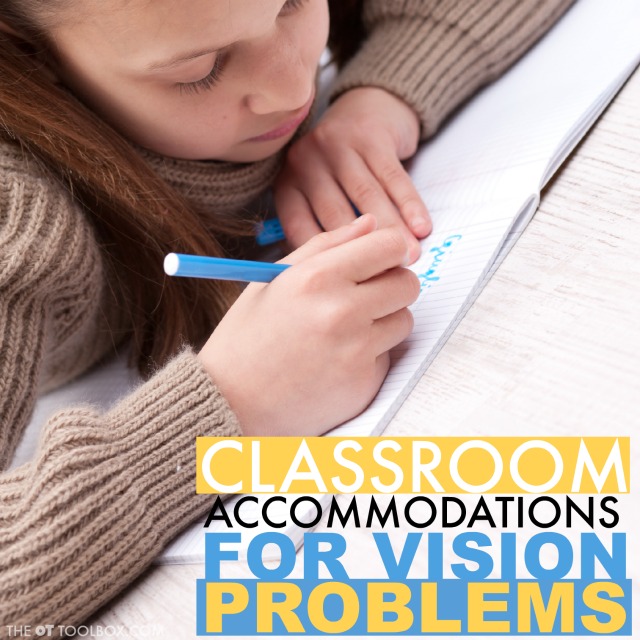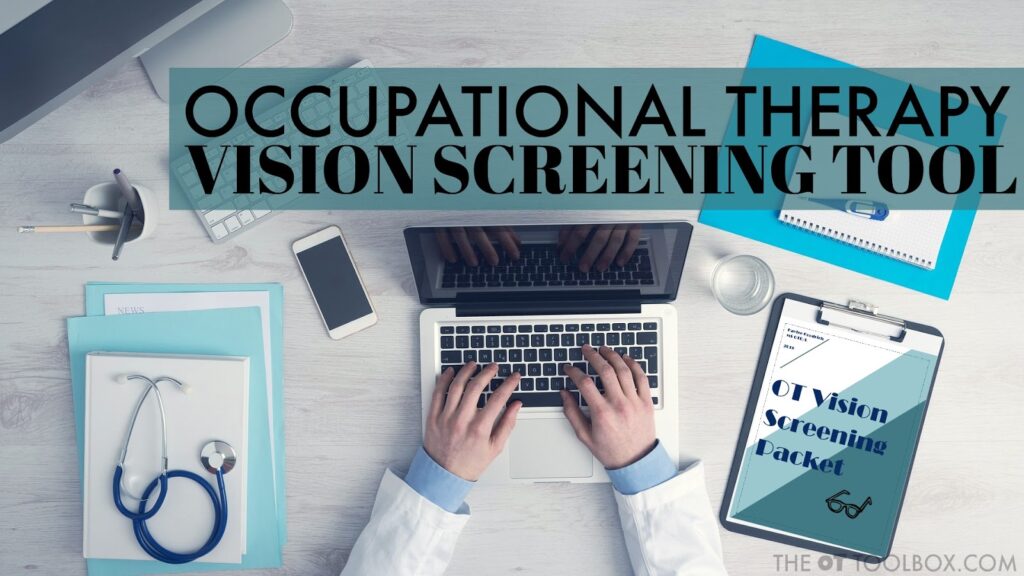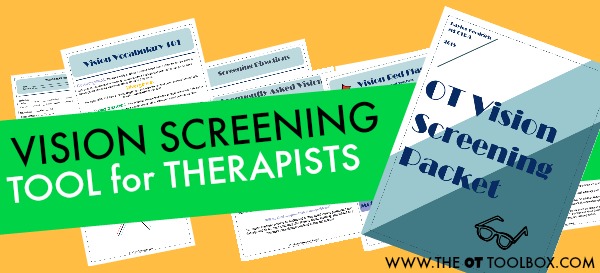Visual Impairments such as convergence insufficiency, impaired visual saccades, or other visual problems like blurred vision can present as a problem in the classroom. Students with visual impairments will flourish with effective classroom accommodations for visual problems. Below, you will find strategies that school-based occupational therapists can use as accommodations for addressing visual needs while meeting educational goals.
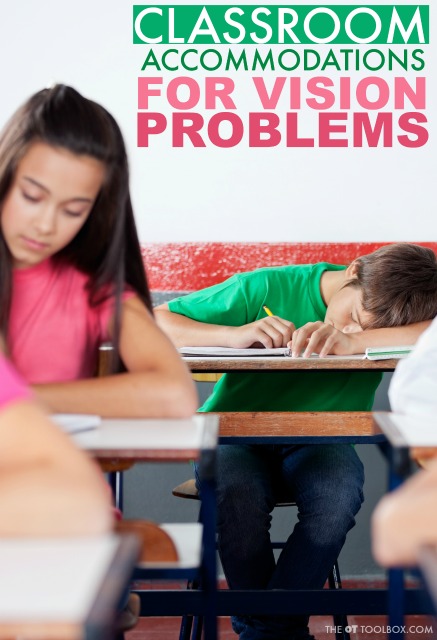
Visual Impairment Accommodations for the Classroom
The fact is, vision impacts learning. When visual problems exist, it can be be helpful to next address what to do about those problems to maximize learning. Often times when vision is discussed as a concern, a parent or caregiver may push back saying that the child has had their vision checked, and that they can see fine. Despite education, and handouts, the parent still resists getting a more in-depth vision evaluation for their child. Now what? Good news is that there are some accommodations that can be made in the classroom to assist the child. These strategies are also great for kiddo’s who already have glasses but are still struggling.
What are accommodations for visual problems?
Accommodations are strategies set forth that allow a student to change the method of how learning happens. Accommodations for visual problems can address visual needs through changes in seating, presentation of visual information, test information, or classroom activities without modifying what is tested, completed, or taught.
The visual accommodations listed below are means for addressing visual problems without changing classroom expectations for learning.
Preferential Seating
Preferential seating means a lot of different things to every professional. Typically, it mean that the kiddo is placed at the front of the room, closest to the teacher where they can receive an increased level of support from the teacher. However, this is not necessarily the best for a child with vision deficits. There are a few keys points to preferential seating for kiddos with vision deficits that should be considered.
● Proximity to the board
● Direction in which the child is facing in relation to the board or main work area
● Level of visual distractions around the room including posters, boards and other children
● Is the goal of seat work and need for use of board to achieve completion of work?
Proximity to the Board
Being closest to the board is not necessarily the best position for a child facing vision challenges particularly if they are not acuity based in nature.
For instance, a child that is struggling with saccades and tracking may not succeed in a front and center position. This would challenge their eyes constantly to look in all directions for information. A better position for them would be to the left or to the right in the first 2-3 rows. This would limit the amount of tracking to either side that would need to be completed.
This position would also benefit a child with who struggles with filtering visual information and needs information to be limited on one side.
When recommending a seat based on proximity to the board, it is important to think about what challenges the kiddo is facing visually and to recommend a seat that promotes success.
Face the Front
Is the Child Facing the Board?
There are a lot of classroom set-ups these days that have children not facing the board or at an awkward angle. This is okay if the child is not expected to copy work from the board or utilize information from the main learning space.
When it doesn’t work, is when the child needs to utilize this information. It is best to have the child facing the board straight on or with a slight angle if they are not seated in the center. Limit turning of the head over 45 degrees to prevent eye strain and an increased chance of the child losing their place when copying.
There are times that it is appropriate to have the child’s back to the board and main learning space. I will get to that in just a moment.
Reduced Visual Distractions
Limiting visual distractions and over stimulation is a large part in helping kids with visual deficits. If there is too much information in front of them or around them, they are more likely to get lost visually, leading to more time needed to complete tasks and increases in errors when copying or missing written steps.
This is one of the few times that it is okay to have a child’s back to the board or main work area. Especially, if the child does not need to see the main area. Typically, this is the case for lower levels of education such as kindergarten through second grade, or when the curriculum begins to focus on board directed teaching.
Other ways to limit visual distractions are to keep the main learning space clear of extraneous posters, charts or decorations, along with conscious choices for seating the child. Having the child’s back to busy walls and a large portion of their peers can be helpful.
Most people think that windows are distractions for kiddos, but for a child with vision deficits, sitting near or facing a window can give a much needed visual “break” from stimulation. So don’t rule out a window seat yet!
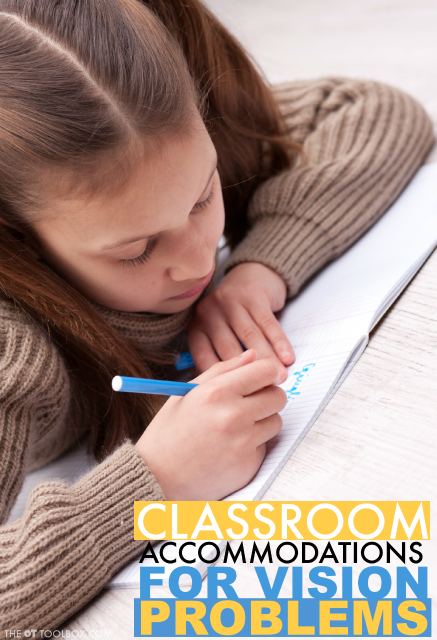
Increased White Space
Worksheets can be very overwhelming for a child with a visual deficit. They may have a hard time reading a busy worksheet, completing a math worksheet or miss parts of multi-step directions.
One way to help avoid this is to provide increased white space. White space refers to the amount of blank or void areas on a piece of paper. The higher the amount of white space, they less likely a child with vision deficits is to struggle.
This means limiting the number of math problems on a page from 6 to 3 for example. Or utilizing the Handwriting Without Tears lined paper versus traditional triple lined paper.
Sometimes changing the handout or worksheet is not an option and other strategies need to be utilized. The use of an extra sheet of paper to block out extra information can be helpful in creating the white space that is needed.
Decreased Visual Distractions
I touched on this in preferential seating section in regards to the overall placement of the child in the room. However, visual distractions can also come from items in the child’s work space. Distractions may include name tags, behavior systems, letter lines, a peer across from them and even work to be completed. These visual distractions may cause the kiddo to feel visually unorganized leading to the appearance of sloppy work and poor time management, and even signs of anxiety.
One way to help eliminate visual distraction within the workspace is to limit what is on the child’s desk. Keep the kiddo’s work space limited to a name tag and one other item. If other items are needed on the desk or workspace, have them arranged so that they are not in the child’s direct line of sight while working.
For instance, crayon boxes and utensils may be shared at a table or grouping of students. Have the items place to the left or right of the child so that their direct line of sight is clear.
Also limit that amount of ‘work’ that is place in front of the kiddo. I say ‘work’ lightly as most ‘work’ for kids are worksheets and craft projects. By presenting one item at a time, it can help the child’s visual space remain clear and help them stay visually organized and on task.
Visual Structure for Reading and Writing
Sometimes limiting visual distractions is not enough support for visual organization. Sometimes, the child needs even more structure to support successful learning patterns and work completion.
One strategy is to provide the child with graph paper to write on. This is very structured and provides concrete boundaries for letter orientation, sizing, and spacing. It also provides visuals for completing math problems in straight lines.
Other forms of visual structure include colored lines to indicate top and bottom of the lines for writing, along with highlighted “spacer” lines for completion of longer work.
Color coding can also be a helpful tool in providing visual structure for older children. It be as general as a different colored folders/notebooks for each subject to allow the child to quickly scan and find what they need, to as complex as writing parts of a math equation in different colors. Or even going as far as to writing the parts of a paragraph in different colors.
Visual structure can be as simple, or as complex as it’s needed to be to meet the kiddo’s needs.
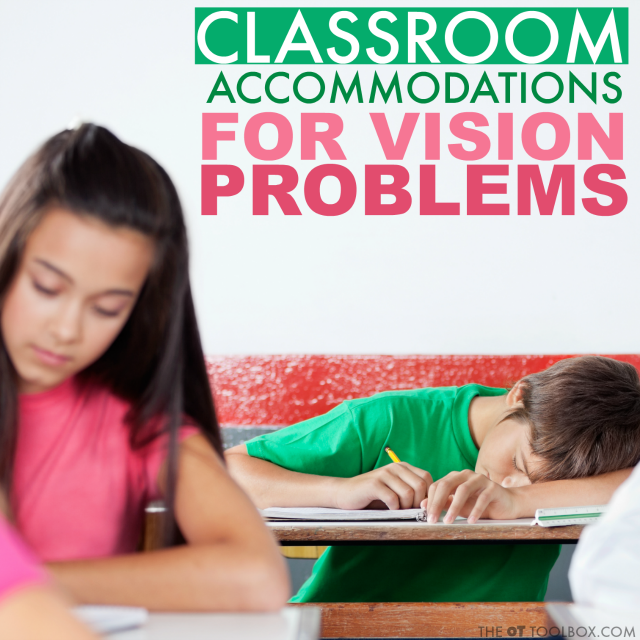
Final Thoughts on Visual Impairment Accommodations
Each child is different and finding the right visual supports is a trial and error process that takes time and patience to work through. Evaluating the child’s weaknesses will help to determine the best supports and path for success in the classroom despite their visual challenges.
More resources that can help with understanding and advocating for visual impairments:
What is Visual Processing and Visual Efficiency?
Visual Saccades and Learning
What is Visual Tracking?
What is Convergence Insufficiency?
What if you suspect vision problems?
Now what? When vision problems are suspected after a screening by the OT, it is best practice to refer the family to a developmental optometrist.
A developmental optometrist will complete a full evaluation and determine the need for corrective lenses, vision therapy or a home program to address vision concerns.
As occupational therapists, it is imperative that we rule out vision problems before treating handwriting or delays in visual motor integration, to ensure the best possible trajectory of development and success for the child.
Occupational Therapy Vision Screening Tool
 A little about Kaylee:
A little about Kaylee: 